Suitable for:
Carbon steel, stainless steel, alloys with chrome or P91/92
Removes:
Iron oxides (rust). Copper oxides can be removed by adjusting the cleaning method for decoppering (only during post-commissioning cleaning). With post-commissioning cleaning, hardness salts (such as calcium carbonate, lime) are also removed.
Cleaning with inhibited citric acid is carried out at a mild pH. However, a high temperature is required to remove the iron oxides. At higher temperatures, citric acid becomes more corrosive, despite its mild pH. Futhermore, inhibitors are needed to counteract the increase in corrosiveness, which can cause a disruption in the second part of the cleaning, namely, the passivation.
Citric acid forms a strong complex with iron, so that the liquid can be made alkaline without the iron precipitating as a hydroxide. This makes it possible to pickle and passivate with citric acid, using one additional liquid (usually hydrogen peroxide or sodium nitrite).
The waste water after cleaning can easily be processed by biological waste water treatment or by the DND method.
Advantages
- Shorter cleaning time;
- Smaller amounts of waste water;
- Passivation with the cleaning liquid;
- Suitable for higher alloyed steels that include chromium or P91/P92;
- Can dissolve copper oxides if present (through an adjusted cleaning procedure);
- Can be used if both carbon steel and stainless steel are present;
- Easy waste water treatment.
Disadvantages
- Does not remove welding skin, mill scale and annealing skin & silicate compounds (welding skin, mill scale and annealing skin are only removed at very high temperatures (90°C);
- Higher cleaning temperature (70-80°C);
- Use of corrosive chemicals;
- Cannot be used if copper piping is present;
- With incorrect use, there is a risk of corrosion of the base material.
